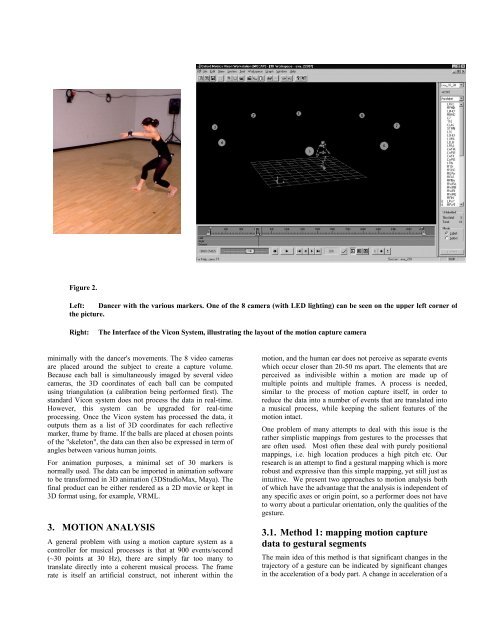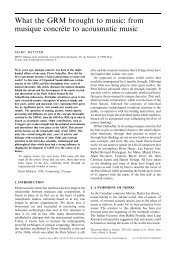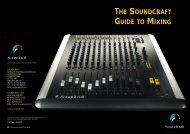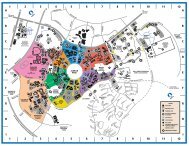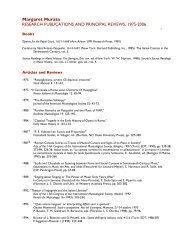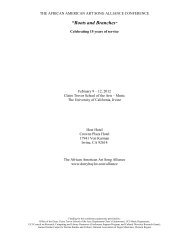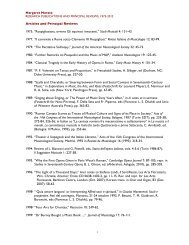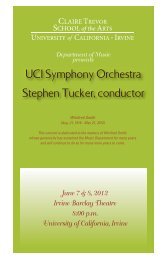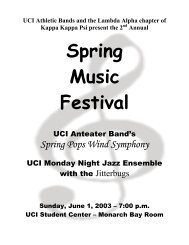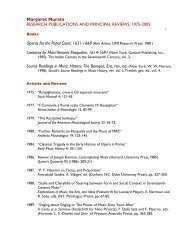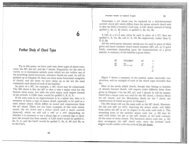3D motion capture data: motion analysis and mapping to music
3D motion capture data: motion analysis and mapping to music
3D motion capture data: motion analysis and mapping to music
You also want an ePaper? Increase the reach of your titles
YUMPU automatically turns print PDFs into web optimized ePapers that Google loves.
Figure 2.<br />
Left: Dancer with the various markers. One of the 8 camera (with LED lighting) can be seen on the upper left corner of<br />
the picture.<br />
Right:<br />
The Interface of the Vicon System, illustrating the layout of the <strong>motion</strong> <strong>capture</strong> camera<br />
minimally with the dancer's movements. The 8 video cameras<br />
are placed around the subject <strong>to</strong> create a <strong>capture</strong> volume.<br />
Because each ball is simultaneously imaged by several video<br />
cameras, the <strong>3D</strong> coordinates of each ball can be computed<br />
using triangulation (a calibration being performed first). The<br />
st<strong>and</strong>ard Vicon system does not process the <strong>data</strong> in real-time.<br />
However, this system can be upgraded for real-time<br />
processing. Once the Vicon system has processed the <strong>data</strong>, it<br />
outputs them as a list of <strong>3D</strong> coordinates for each reflective<br />
marker, frame by frame. If the balls are placed at chosen points<br />
of the "skele<strong>to</strong>n", the <strong>data</strong> can then also be expressed in term of<br />
angles between various human joints.<br />
For animation purposes, a minimal set of 30 markers is<br />
normally used. The <strong>data</strong> can be imported in animation software<br />
<strong>to</strong> be transformed in <strong>3D</strong> animation (<strong>3D</strong>StudioMax, Maya). The<br />
final product can be either rendered as a 2D movie or kept in<br />
<strong>3D</strong> format using, for example, VRML.<br />
3. MOTION ANALYSIS<br />
A general problem with using a <strong>motion</strong> <strong>capture</strong> system as a<br />
controller for <strong>music</strong>al processes is that at 900 events/second<br />
(~30 points at 30 Hz), there are simply far <strong>to</strong>o many <strong>to</strong><br />
translate directly in<strong>to</strong> a coherent <strong>music</strong>al process. The frame<br />
rate is itself an artificial construct, not inherent within the<br />
<strong>motion</strong>, <strong>and</strong> the human ear does not perceive as separate events<br />
which occur closer than 20-50 ms apart. The elements that are<br />
perceived as indivisible within a <strong>motion</strong> are made up of<br />
multiple points <strong>and</strong> multiple frames. A process is needed,<br />
similar <strong>to</strong> the process of <strong>motion</strong> <strong>capture</strong> itself, in order <strong>to</strong><br />
reduce the <strong>data</strong> in<strong>to</strong> a number of events that are translated in<strong>to</strong><br />
a <strong>music</strong>al process, while keeping the salient features of the<br />
<strong>motion</strong> intact.<br />
One problem of many attempts <strong>to</strong> deal with this issue is the<br />
rather simplistic <strong>mapping</strong>s from gestures <strong>to</strong> the processes that<br />
are often used. Most often these deal with purely positional<br />
<strong>mapping</strong>s, i.e. high location produces a high pitch etc. Our<br />
research is an attempt <strong>to</strong> find a gestural <strong>mapping</strong> which is more<br />
robust <strong>and</strong> expressive than this simple <strong>mapping</strong>, yet still just as<br />
intuitive. We present two approaches <strong>to</strong> <strong>motion</strong> <strong>analysis</strong> both<br />
of which have the advantage that the <strong>analysis</strong> is independent of<br />
any specific axes or origin point, so a performer does not have<br />
<strong>to</strong> worry about a particular orientation, only the qualities of the<br />
gesture.<br />
3.1. Method 1: <strong>mapping</strong> <strong>motion</strong> <strong>capture</strong><br />
<strong>data</strong> <strong>to</strong> gestural segments<br />
The main idea of this method is that significant changes in the<br />
trajec<strong>to</strong>ry of a gesture can be indicated by significant changes<br />
in the acceleration of a body part. A change in acceleration of a


